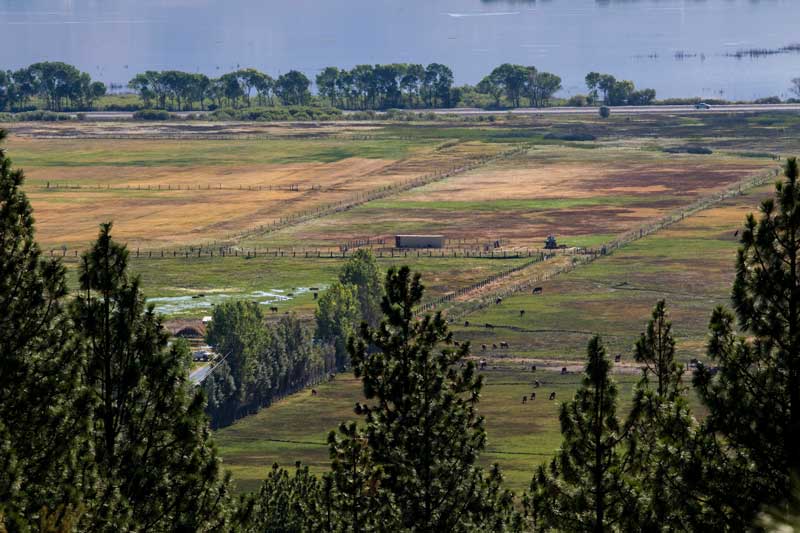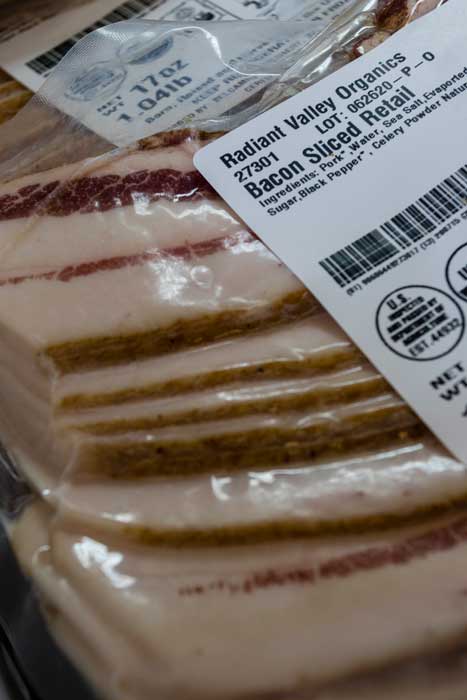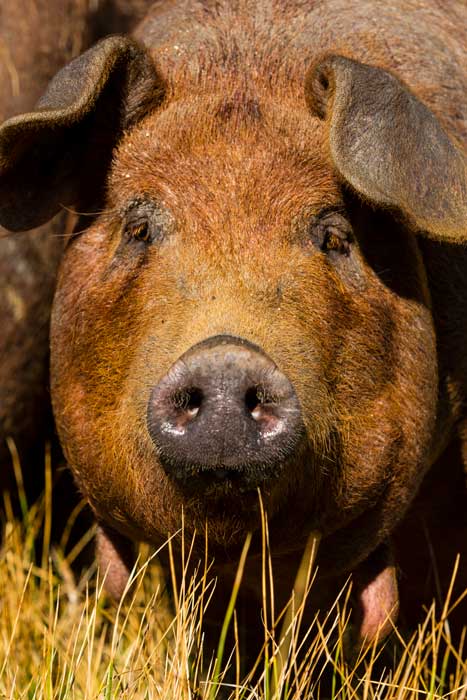Radiant Valley Organics revives heritage hog population.
It’s 5 a.m., and Kristina and Damon Shea, plus their three children, are up and ready to feed their 40 heritage hogs, which are spread out between two properties in Washoe Valley. When the family finishes, it’s off to school and work — for Kristina, Tahoe Expedition Academy, and her husband, C&S Waste Solutions.
“With the cost of feed and the cost of the certified organic farmland in Washoe Valley, we don’t even pay for our labor or include that cost in the price of our pork. The project is about increasing the certified organic education, increasing the healthy meats in the pork supply, and pushing local farming basically because we’re crazy,” Kristina says with a laugh.

The Sheas’ hog pasture
It doesn’t take long to realize just how passionate Kristina is about raising the red wattle, an endangered breed named for its auburn coloring and pair of tassels hanging from its neck. The red hogs have been in North America since the mid-1800s, according to the Red Wattle Hog Association, but approached extinction with fewer than 50 red wattles from six breeders accounted for in 1999. Today, the association has more than 100 members and 100 hogs registered annually. Ironically, creating consumer demand for this heritage breed is the key to its survival.
World of wattles
Kristina first encountered the red wattle on a neighboring farm in Mendocino County, Calif., where she purchased her first plot of land at age 19 and began a journey that would lead her to vegetable farming and raising sheep, chickens, llamas, and dairy cows over the years.
“On that farm, they always gave their cows a lot of space, but for some reason, they weren’t interested in giving the pigs the appropriate amount of space that I think pigs deserve,” Kristina says.
She was drawn to the red wattles’ docile nature and great personalities. The situation pushed her to learn about the even more horrific conditions that pigs are subjected to in factory farms, where they are crammed inside on concrete floors with little room to move.

Kristina Shea tends to her hogs
So eight years ago, on an off-the-grid property in Plumas National Forest, Kristina and Damon purchased their first red wattle, the matriarch of their current passel of hogs, Violet.
Hog heaven
Today, the Sheas raise their pigs on two properties in Washoe Valley, one forested and the other with pasture, with ample room to roam and root and following strict standards set forth by the California Certified Organic Farmers, a United States Department of Agriculture-accredited organic certifying agency and advocate. Radiant Valley’s organic certification is renewed each year with a two-day visit from an accreditor who inspects and tests every facet of the farm, from feed and water to soil and bedding, to make sure it’s free of GMOs, pesticides, herbicides, hormones, and antibiotics.
“We’re the only certified-organic pork producer in the whole area,” Kristina notes. “If farmers are advertising [that they are] organic but not [that they are] certified, pesticide free, natural, or sustainably raised, no standards are in place to validate the claims if they don’t have CCOF or a national organic program watching over them. For us, it’s about holding to those standards, pushing the certified-organic movement forward and trying to inspire others to get why it’s so important to have that certification.”

Radiant Valley Organics bacon is certified organic and sustainably raised
Raising certified-organic heritage hogs comes at a high price, Kristina admits, both in time and money. It takes 11 months for the red wattles to reach their market size of 350 to 400 pounds, while in a factory farming operation, it’s more like six months. And the certified-organic feed costs around 47 cents per pound compared to nonorganic feed at 5 to 10 cents per pound, Kristina explains. But she wouldn’t do it any other way.
“It’s really about a holistic system of protecting wildlife and biodiversity, enhancing the soil fertility, and also having the regulations supported by the federal law,” she says.
The result is high-end, certified-organic cuts of pork ranging from smoked ham to pork sirloin steak. The red wattle produces a lean, tender meat with a flavor profile somewhere between pork and beef.
After almost two years of selling pork to the public, Kristina hopes to continue expanding her operation with more red wattles and eventually conduct research into the nutritional differences between pork from pigs raised as hers are and pork from a factory farm.
“The pork consumption in our country and the way pigs are raised are horrifying,” Kristina says. “If I didn’t raise these pigs, I wouldn’t eat pork. We work really hard to produce a really nutritious, very healthy pig.”
Radiant Valley Organics’ pork now is available at the Great Basin Community Food Co-op in Reno, as well as online for delivery, shipping, or pickup at Radiantvalleyorganics.com.
Claire McArthur is a freelance writer who — as is usually the case when she writes farming articles — has changed the way she thinks about her food and, more specifically, her bacon consumption.
Pan-Roasted Bone-in Pork Chops, Caramelized Onion and Apples, and Grainy Mustard Jus
(courtesy of Radiant Valley Organics in Washoe Valley. Serves 4)
½ tablespoon black pepper, freshly cracked
1 teaspoon whole cloves
4 tablespoons dried thyme
1 cup sugar
¾ cup kosher salt
1 tablespoon garlic, minced
1 gallon water
4 bone-in Radiant Valley pork chops
3 tablespoons oil
Prepare brine by combining black pepper, cloves, thyme, sugar, salt, garlic, and water, then stir until salt and sugar are dissolved. Put pork in shallow pan or zip-lock bag and brine for at least 4 hours or overnight.
Remove pork from brine and rinse with cold water. Pat dry with paper towels. Heat oil in large sauté pan over high heat. Sear chops on both sides until they’re golden brown and the internal temperature reaches about 145 degrees F. Place chops on platter and cover with foil, then set aside as you prepare jus and apples and onions.
To serve, place pork chops on bed of the caramelized apples and onions, and drizzle the sauce over the top. Goes great with buttermilk mashed potatoes!
For caramelized apples and onions
2 apples, peeled and sliced lengthwise in ½-inch pieces
1 yellow onion, cut lengthwise in thin pieces, or julienned
3 tablespoons apple cider vinegar
4 tablespoons salted butter
Salt and pepper, to taste
Place sauté pan on medium heat, then add butter, onions, and apples. Sauté until caramelized, about 12 minutes. Add apple cider vinegar and cook for another 5 minutes. Salt to taste.
For grainy mustard jus
¼ cup white wine
¼ cup chicken stock
2 tablespoons whole-grain mustard
4 tablespoons salted butter
2 tablespoons honey
After preparing pork chops in the large sauté pan and removing them, keep pan on heat and deglaze with the white wine. Add chicken stock, mustard, and honey, and reduce until sauce thickly coats the back of a spoon. Whisk in butter and season with salt to taste.


